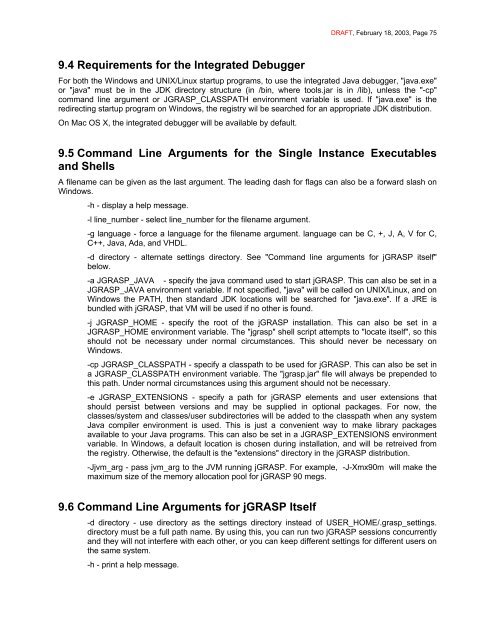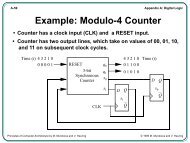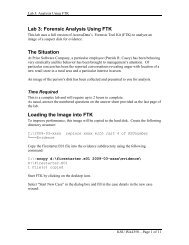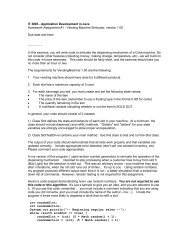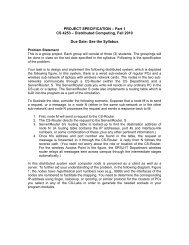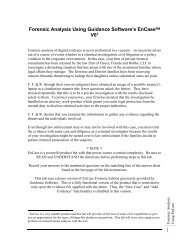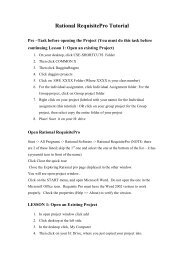Create successful ePaper yourself
Turn your PDF publications into a flip-book with our unique Google optimized e-Paper software.
9.4 Requirements for the Integrated Debugger<br />
DRAFT, February 18, 2003, Page 75<br />
For both the Windows and UNIX/Linux startup programs, to use the integrated Java debugger, "java.exe"<br />
or "java" must be in the JDK directory structure (in /bin, where tools.jar is in /lib), unless the "-cp"<br />
command line argument or JGRASP_CLASSPATH environment variable is used. If "java.exe" is the<br />
redirecting startup program on Windows, the registry wil be searched for an appropriate JDK distribution.<br />
On Mac OS X, the integrated debugger will be available by default.<br />
9.5 Command Line Arguments for the Single Instance Executables<br />
and Shells<br />
A filename can be given as the last argument. The leading dash for flags can also be a forward slash on<br />
Windows.<br />
-h - display a help message.<br />
-l line_number - select line_number for the filename argument.<br />
-g language - force a language for the filename argument. language can be C, +, J, A, V for C,<br />
C++, Java, Ada, and VHDL.<br />
-d directory - alternate settings directory. See "Command line arguments for jGRASP itself"<br />
below.<br />
-a JGRASP_JAVA - specify the java command used to start jGRASP. This can also be set in a<br />
JGRASP_JAVA environment variable. If not specified, "java" will be called on UNIX/Linux, and on<br />
Windows the PATH, then standard JDK locations will be searched for "java.exe". If a JRE is<br />
bundled with jGRASP, that VM will be used if no other is found.<br />
-j JGRASP_HOME - specify the root of the jGRASP installation. This can also be set in a<br />
JGRASP_HOME environment variable. The "<strong>jgrasp</strong>" shell script attempts to "locate itself", so this<br />
should not be necessary under normal circumstances. This should never be necessary on<br />
Windows.<br />
-cp JGRASP_CLASSPATH - specify a classpath to be used for jGRASP. This can also be set in<br />
a JGRASP_CLASSPATH environment variable. The "<strong>jgrasp</strong>.jar" file will always be prepended to<br />
this path. Under normal circumstances using this argument should not be necessary.<br />
-e JGRASP_EXTENSIONS - specify a path for jGRASP elements and user extensions that<br />
should persist between versions and may be supplied in optional packages. For now, the<br />
classes/system and classes/user subdirectories will be added to the classpath when any system<br />
Java compiler environment is used. This is just a convenient way to make library packages<br />
available to your Java programs. This can also be set in a JGRASP_EXTENSIONS environment<br />
variable. In Windows, a default location is chosen during installation, and will be retreived from<br />
the registry. Otherwise, the default is the "extensions" directory in the jGRASP distribution.<br />
-Jjvm_arg - pass jvm_arg to the JVM running jGRASP. For example, -J-Xmx90m will make the<br />
maximum size of the memory allocation pool for jGRASP 90 megs.<br />
9.6 Command Line Arguments for jGRASP Itself<br />
-d directory - use directory as the settings directory instead of USER_HOME/.grasp_settings.<br />
directory must be a full path name. By using this, you can run two jGRASP sessions concurrently<br />
and they will not interfere with each other, or you can keep different settings for different users on<br />
the same system.<br />
-h - print a help message.


